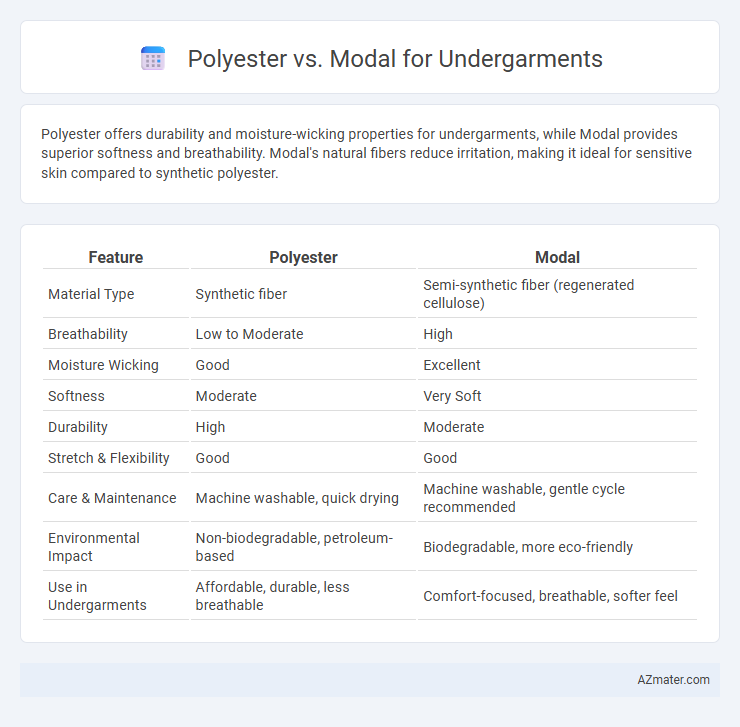Polyester offers durability and moisture-wicking properties for undergarments, while Modal provides superior softness and breathability. Modal's natural fibers reduce irritation, making it ideal for sensitive skin compared to synthetic polyester.
Table of Comparison
| Feature | Polyester | Modal |
|---|---|---|
| Material Type | Synthetic fiber | Semi-synthetic fiber (regenerated cellulose) |
| Breathability | Low to Moderate | High |
| Moisture Wicking | Good | Excellent |
| Softness | Moderate | Very Soft |
| Durability | High | Moderate |
| Stretch & Flexibility | Good | Good |
| Care & Maintenance | Machine washable, quick drying | Machine washable, gentle cycle recommended |
| Environmental Impact | Non-biodegradable, petroleum-based | Biodegradable, more eco-friendly |
| Use in Undergarments | Affordable, durable, less breathable | Comfort-focused, breathable, softer feel |
Introduction to Polyester and Modal Fabrics
Polyester is a synthetic fiber derived from petroleum, known for its durability, wrinkle resistance, and quick-drying properties, making it a popular choice in undergarments. Modal, a semi-synthetic fiber made from beech tree cellulose, offers exceptional softness, breathability, and moisture-wicking capabilities, enhancing comfort in intimate wear. Both fabrics provide unique benefits, with polyester excelling in strength and longevity, while modal stands out for its natural feel and eco-friendly production process.
Fiber Origins and Production Processes
Polyester, derived from petroleum-based synthetic polymers, undergoes a chemical polymerization process involving ethylene glycol and terephthalic acid, resulting in strong, durable fibers ideal for moisture-wicking undergarments. Modal, a semi-synthetic fiber made from reconstituted beech tree cellulose, follows a more natural production process where wood pulp is treated with sodium hydroxide and carbon disulfide to create viscose, offering superior breathability and softness for intimate apparel. The contrasting fiber origins and manufacturing methods directly impact the comfort, sustainability, and performance of undergarments made from these materials.
Comfort and Softness Comparison
Modal fibers provide superior softness and breathability compared to polyester, making them ideal for comfortable undergarments that feel gentle on the skin. Polyester, while durable and moisture-wicking, tends to retain heat and can feel less smooth, potentially causing irritation during extended wear. Modal's natural cellulose base enhances moisture absorption and softness, offering a more luxurious and comfortable experience in intimate apparel.
Moisture-Wicking and Breathability
Polyester offers excellent moisture-wicking properties, quickly drawing sweat away from the skin to keep undergarments dry during intense activities. Modal, a semi-synthetic fiber made from beech tree pulp, excels in breathability, providing a soft, lightweight feel that enhances comfort and airflow. Combining polyester's moisture management with modal's natural breathability results in undergarments that maintain dryness while allowing superior ventilation.
Durability and Longevity
Polyester undergarments offer superior durability due to their resistance to stretching, shrinking, and abrasion, making them ideal for long-term use. Modal fabric, while softer and more breathable, tends to have a shorter lifespan as it is more prone to pilling and damage from frequent washing. Choosing polyester ensures extended longevity and maintains shape and texture better under constant wear and laundering.
Skin Sensitivity and Allergen Potential
Polyester undergarments often cause discomfort for sensitive skin due to their synthetic fibers, which can trap heat and moisture, increasing the risk of irritation and allergic reactions. Modal, a semi-synthetic fabric derived from beech tree cellulose, provides superior breathability and moisture-wicking properties, reducing skin irritation and allergen potential. Dermatological studies highlight modal's hypoallergenic nature, making it a preferred choice for individuals prone to skin sensitivities and eczema.
Environmental Impact and Sustainability
Modal fabric is derived from beech tree pulp and is biodegradable, making it a more sustainable option for undergarments compared to polyester, which is a synthetic fiber produced from petroleum and has a significantly larger carbon footprint. Polyester's production consumes high amounts of energy and releases microplastics into waterways during washing, contributing to environmental pollution. Modal fibers require less water and energy to produce, and their biodegradability reduces long-term environmental impact, supporting more eco-friendly and sustainable undergarment choices.
Price and Affordability
Polyester undergarments typically offer a more budget-friendly option, making them a popular choice for consumers seeking durability and cost-efficiency. Modal fabric, derived from beech tree pulp, generally comes at a higher price point due to its softness and moisture-wicking properties. Choosing between polyester and modal depends on balancing affordability with comfort and fabric performance preferences.
Care Instructions and Maintenance
Polyester undergarments require machine washing in cold water and tumble drying on low heat to maintain fabric integrity and prevent shrinkage. Modal fabric, being more delicate, demands gentle machine wash cycles or hand washing, avoiding bleach and high heat drying to retain softness and elasticity. Proper care extends the lifespan of both materials while preserving comfort and fit.
Choosing the Best Fabric for Your Undergarments
Polyester offers durability, wrinkle resistance, and moisture-wicking properties, making it ideal for active wear and everyday undergarments that require longevity and easy care. Modal, a type of rayon made from beech tree pulp, excels in softness, breathability, and moisture absorption, providing superior comfort and temperature regulation for sensitive skin. Choosing the best fabric depends on your priorities: select polyester for performance and maintenance, or modal for softness and enhanced comfort.

Infographic: Polyester vs Modal for Undergarment
 azmater.com
azmater.com